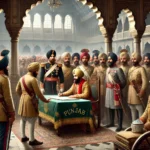PAK YATRA is a tour operator company providing tour services and facilitates Sikh community from different parts of the world.
Shahi Eid Gah Mosque: A Testament to Multan’s Heritage
Importance of This Place:
The Shahi Eid Gah Mosque, situated in Multan, Punjab, holds profound importance as an architectural marvel and a significant historical site. Built in 1735 CE during the reign of Mughal Emperor Muhammad Shah, it served not only as a place of worship but also as a symbol of cultural and religious identity for the local community.
Story Behind:
Commissioned by Nawab Abdul Samad Khan, the Mughal governor of Multan, the mosque was constructed to cater to the religious needs of the people and as a grand gesture of patronage towards the community. Over the centuries, it witnessed significant events, including the Siege of Multan in 1848, which led to its partial destruction due to an explosion caused by a British cannon.
Location:
The Shahi Eid Gah Mosque is located in Usmanabad Colony, Khanewal Road, off the Multan-Lahore Highway, in the northeastern part of the oldest section of Multan city, Punjab, Pakistan. It stands adjacent to the 20th-century Sufi shrine of Ahmad Saeed Kazmi, adding to the spiritual significance of the area.
Latitude and Longitude:
Latitude: 30.210794444
Longitude: 71.478938889
Preservation Efforts:
Despite facing damage and conversion into a garrison during the Sikh rule, and later serving as a courthouse during the British era, the mosque has been restored multiple times to preserve its historical and architectural integrity. Efforts are ongoing, with custodians from the family of Sahibzada Ahmad Saeed Kazmi leading restoration efforts.
Architectural Marvel:
The mosque’s architecture reflects late-Mughal design elements, characterized by its spacious courtyard and a prayer chamber adorned with seven domes. Glazed blue Multan-style tiles embellish the exterior, while intricate mosaics decorate the interior, showcasing the craftsmanship of the era.
Historical Evolution:
From its construction in the 18th century to its use as a garrison and later as a courthouse during different periods of history, the Shahi Eid Gah Mosque has evolved in function while retaining its significance as a religious and cultural landmark in Multan.
Background:
As a testament to the piety and patronage of Nawab Abdul Samad Khan, the mosque represents the cultural and religious heritage of Multan under Mughal rule. Its design, inspired by traditional Mughal-era mosques, reflects the architectural trends of the time and stands as a reminder of Multan’s rich history.
Historical Significance:
The Shahi Eid Gah Mosque witnessed significant historical events, including the Siege of Multan, which led to its partial destruction. Despite these challenges, its restoration and continued use as a place of worship underscore its enduring historical significance and cultural importance for the people of Multan and Pakistan as a whole.




